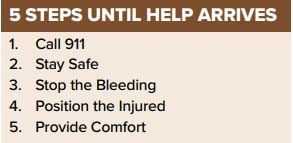“When I opened up the car door, the first thing I saw was a dark red circle on his elbow where the rest of his arm used to be.”
As a 15-year-old taking the emergency medical responder course through a soup kitchen, I was mesmerized by stories like this told by Tom, our instructor. Tom was not a provider himself, but he was always the first person to drop everything in the case of an emergency to see who may need help. This story about an accident on an interstate resulting in a traumatic amputation not only solidified the importance of tourniquets for me, but it also piqued my interest in emergency medicine and set me on my current path early in my adolescence. Educating citizens on how they can help during emergencies outside of the hospital has become more and more important as mass casualty incidents become less uncommon.
Background

For a long time, prehospital emergency medicine education was limited to those training for jobs in the field. Only in the last several decades have mass education initiatives emphasized emergency medicine knowledge all citizens should know. For example, bystander CPR rates have increased dramatically due to education and instruction from 911 call centers. CPR education has been so successful it is likely the first prehospital emergency intervention that comes to mind for most citizens. However, there is more bystanders can do in emergency situations, as demonstrated by the Stop the Bleed program developed in 2015 by the American College of Surgeons and the Department of Homeland Security. Stop the Bleed has trained more than one million people worldwide in tourniquet use and bleeding control.1 Hoping to have similar success with a broader curriculum, the new Until Help Arrives program developed by FEMA and ACEP in 2017 is the newest and arguably most comprehensive example of a citizen emergency medicine education program. The goal of Until Help Arrives is to prepare citizens to be safer and more effective in a variety of emergency situations, as opposed to focusing on specific prehospital interventions.
Need for the Program
A poll of over 2000 adults conducted by ACEP in 2019 found that a majority of respondents are not confident in their ability to help in the case of respiratory arrest, car accidents, severe bleeding, natural disasters, gunshot wounds, or mass shootings.2 Subjective readiness and willingness to help in the case of an emergency depended on whether respondents had received any sort of emergency medicine training or not. For example, 54% of those with emergency training reported confidence in helping in a natural disaster scenario, while only 30% with no medical training reported confidence. Clearly citizens need more training to become more confident in emergency scenarios, but would it truly lead to more assistance provided when the need arises? Fortunately, 92% of respondents reported they would be more willing to assist in emergency situations if they received the Until Help Arrives training.3 With 911 dispatch training constantly improving, simply being more willing to provide assistance could be enough to make a huge difference to injured people in emergencies.
UHA Curriculum
There are several delivery mechanisms for the Until Help Arrives curriculum, but all versions emphasize the same five steps: call 911, stay safe, stop the bleeding, position the injured, and provide comfort. Several of these steps such as calling 911 and controlling bleeding are usually mentioned in other education campaigns. An emphasis on scene safety and reassurance of injured people is a strength of this curriculum. The course also delves into the realities of calling 911, promoting concise communication with dispatchers, enabling rapid activation of other responders.
A highlight of the training features audio of a 911 call where a bystander assists their neighbor who has suffered a gunshot wound to their leg. It truly exemplifies the concepts of scene safety, 911 communication, and providing reassurance to victims. There are several versions of the training available to the public, with varying degrees of instructor involvement.
Two different interactive training modules exist on the FEMA website, taking either 5 or 30 minutes to complete. Once instructors register for with ACEP, they have access to the one-hour training presentation and the store to buy equipment such as tourniquets, bleeding control trainers, and simulated blood. Grants may be available at your institutions to purchase the materials for community education, but instructors on a budget can improvise with cheap materials such as pool noodles to simulate bleeding control kits.
Conclusion
Whether you are a veteran educator in courses such as CPR and Stop the Bleed or you have never taught prehospital medicine to your community, definitely check out the Until Help Arrives movement. This course has the potential to empower many people to be more confident and competent in emergency situations. Even the time between dispatch and arrival of EMS providers can be critical to some patients, so this knowledge will save lives. And who knows? You may even inspire members of the next generation of emergency medicine providers.
Resources and Links
- ACEP Until Help Arrives Homepage https://www.acep.org/uha
- FEMA Until Help Arrives Homepage https://community.fema.gov/until-help-arrives
- Until Help Arrives Presentation Deck https://www.fema.gov/media-library/assets/documents/167907
Note: Due to the current COVID-19 pandemic the ACEP has recommended the suspension of all in-person Until Help Arrives courses, but it is certainly not too early to sign up as an instructor and to familiarize yourself with the materials and curriculum!
References
- Our Story. Stopthebleed.org. https://www.stopthebleed.org/our-story. Accessed April 3, 2020.
- ACEP. Poll: Adults Unprepared to Help in a Medical Emergency. https://www.emergencyphysicians.org/siteassets/files/pdfs/acep_untilhelparrives_poll-deck----read-only1-----read-only.pdf. Published October 2019. Accessed March 29, 2020.
- Poll: Majority of Americans Unprepared to Help in a Major Emergency. Emergencyphysicians.org. https://www.emergencyphysicians.org/article/campaigns/until-help-arrives/untilhelparrivespoll. Published October 2019. Accessed March 29, 2020.



